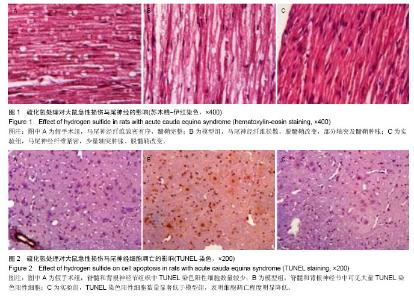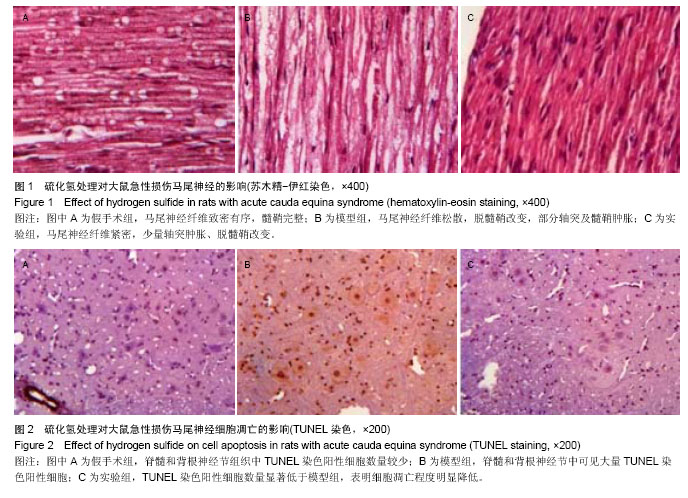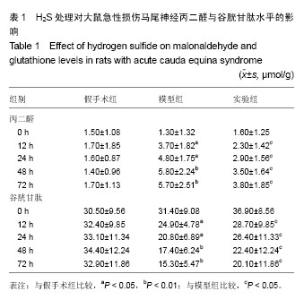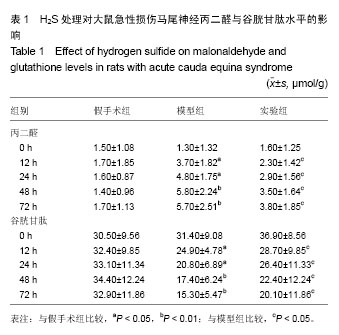| [1] Todd NV.Cauda equina syndrome: findings on perineal examination.Br J Neurosurg.2013;27(6):852.
[2] Hung-Kai WR,Chang MC,Feng SW,et al.Progressive growth of arachnoid cysts with cauda equina syndrome after lumbar spine surgery.J Chin Med Assoc.2013;76(9):527-531.
[3] Shunmugavel A,Martin MM,Khan M,et al.Simvastatin ameliorates cauda equina compression injury in a rat model of lumbar spinal stenosis.J Neuroimmune Pharmacol. 2013; 8(1):274-286.
[4] Guo W,Kan JT,Cheng ZY,et al.Hydrogen sulfide as an endogenous modulator in mitochondria and mitochondria dysfunction.Oxid Med Cell Longev.2012;2012:878052.
[5] Kimura Y,Kimura H.Hydrogen sulfide protects neurons from oxidative stress.FASEB J.2004;18(10):1165-1167.Umemura K,Kimura H.Hydrogen sulfide enhances redueing activity in neurons:neurotrophic role ofH2S in the brain?Antioxid Redox Signal.2007;9(11):2035-2041.
[6] Watanabe K,Konno S,Sekiguchi M,et al.Spinal stenosis: assessment of motor function, VEGF expression and angiogenesis in an experimental model in the rat. Eur Spine J.2007;16(11):1913-1918.
[7] Gardner A,Gardner E,Morley T.Cauda equina syndrome: a review of the current clinical and medico-legal position.Eur Spine J.2011;20(5):690-697.
[8] Head E,Rofina J,Zicker S.Oxidative stress, aging, and central nervous system disease in the canine model of human brain aging.Vet Clin North Am Small Anim Pract.2008;38(1): 167-178.
[9] Lehtinen MK,Bonni A.Modeling oxidative stress in the central nervous system. Curr Mol Med.2006;6(8):871-881.
[10] Jia Z,Zhu H,Li J,et al.Oxidative stress in spinal cord injury and antioxidant-based intervention.Spinal Cord.2012; 50(4): 264-274.
[11] Yousuf S,Atif F,Kesherwani V,et al.Neuroprotective effects of Tacrolimus (FK-506) and Cyclosporin (CsA) in oxidative injury. Brain Behav.2011;1(2):87-94.
[12] Schieber M,Chandel NS.ROS Function in Redox Signaling and Oxidative Stress. Curr Biol.2014;24(10):R453-R462.
[13] Kimura H.Hydrogen sulfide: its production, release and functions.Amino Acids.2011;41(1):113-121.
[14] Kimura H.Hydrogen sulfide as a neuromodulator.Mol Neurobiol.2002;26(1):13-19.
[15] Zhao W,Zhang J,Lu Y,et al.The vasorelaxant effect of H(2)S as a novel endogenous gaseous K(ATP) channel opener. EMBO J.2001;20(21):6008-6016.
[16] Kesherwani V,Nelson KS,Agrawa SK.Effect of sodium hydrosulphide after acute compression injury of spinal cord. Brain Res.2013;1527(2013):222-229.
[17] Campolo M,Esposito E,Ahmad A,et al.A hydrogen sulfide-releasing cyclooxygenase inhibitor markedly accelerates recovery from experimental spinal cord injury. FASEB J.2013;27:4489-4499.
[18] Franson RC,Saal JS,Saal JA.Human disc phospholipase A2 is inflammatory. Spine (Phila Pa 1976).1992;17(6 Suppl): S129-S132.
[19] Orendácová J,Cízková D,Kafka J,et al.Cauda equina syndrome. Prog Neurobiol.2001;64(6):613-637.
[20] Cao Y,Li G,Wang YF,et al.Neuroprotective effect of baicalin on compression spinal cord injury in rats.Brain Res.2010;1357: 115-123.
[21] Walisser JA,Thies RL.Poly (ADP-ribose) polymerase inhibition in oxidant-stressed endothelial cells prevents oncosis and permits caspase activation and apoptosis.Exp Cell Res.1999;251(2):401-413.
[22] Mandal MN,Patlolla JM,Zheng L,et al.Curcumin protects retinal cells from light-and oxidant stress-induced cell death. Free Radic Biol Med.2009;46(5):672-679.
[23] Assi K,Pillai R,Gomez-Munoz A,et al.The specific JNK inhibitor SP600125 targets tumour necrosis factor-alpha production and epithelial cell apoptosis in acute murine colitis.Immunology.2006;118(1):112-121.
[24] Hardy P,Beauchamp M,Sennlaub F,et al.Inflammatory lipid mediators in ischemic retinopathy.Pharmacol Rep.2005; 57(Suppl):169-190.
[25] Lee S,Park Y,Zuidema MY,et al.Effects of interventions on oxidative stress and inflammation of cardiovascular diseases. World J Cardiol.2011;3(1):18-24.
[26] Teke Z,Aytekin FO,Kabay B,et al.Pyrrolidine dithiocarbamate prevents deleterious effects of remote ischemia/reperfusion injury on healing of colonic anastomoses in rats.World J Surg.2007;31(9):1835-1842.
[27] May JM,Qu Z,Li X.Requirement for GSH in recycling of ascorbic acid in endothelial cells.Biochem Pharmacol. 2001; 62(7):873-881.
[28] Chong ZZ,Kang JQ,Maiese K.Essential cellular regulatory elements of oxidative stress in early and late phases of apoptosis in the central nervous system.Antioxid Redox Signal.2004;6(2):277-287.
[29] Liu D,Li L,Augustus L.Prostaglandin release by spinal cord injury mediates production of hydroxyl radical, malondialdehyde and cell death: a site of the neuroprotective action of methylprednisolone.J Neurochem.2001;77(4): 1036-1047.
[30] Uhler TA,Frim DM, Pakzaban P,et al.The effects of megadose methylprednisolone and U-78517F on toxicity mediated by glutamate receptors in the rat neostriatum. Neurosurgery. 1994; 34(1):122-128. |



